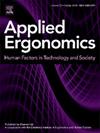Computer vision and tactile glove: A multimodal model in lifting task risk assessment
IF 3.4
2区 工程技术
Q2 ENGINEERING, INDUSTRIAL
引用次数: 0
Abstract
Work-related injuries from overexertion, particularly lifting, are a major concern in occupational safety. Traditional assessment tools, such as the Revised NIOSH Lifting Equation (RNLE), require significant training and practice for deployment. This study presents an approach that integrates tactile gloves with computer vision (CV) to enhance the assessment of lifting-related injury risks, addressing the limitations of existing single-modality methods. Thirty-one participants performed 2747 lifting tasks across three lifting risk categories (LI < 1, 1 ≤ LI ≤ 2, LI > 2). Features including hand pressure measured by tactile gloves during each lift and 3D body poses estimated using CV algorithms from video recordings were combined and used to develop prediction models. The Convolutional Neural Network (CNN) model achieved an overall accuracy of 89 % in predicting the three lifting risk categories. The results highlight the potential for a real-time, non-intrusive risk assessment tool to assist ergonomic practitioners in mitigating musculoskeletal injury risks in workplace environments.
计算机视觉与触觉手套:一种多模态的起重作业风险评估模型
过度劳累造成的工伤,特别是举重,是职业安全的一个主要问题。传统的评估工具,如修订NIOSH提升方程(RNLE),需要大量的培训和实践才能部署。本研究提出了一种将触觉手套与计算机视觉(CV)相结合的方法,以增强对举重相关损伤风险的评估,解决了现有单模态方法的局限性。31名参与者在三个举重风险类别中执行2747项举重任务(LI <;1、1≤LI≤2,LI >;2).将每次升降过程中通过触觉手套测量的手部压力和通过视频记录的CV算法估计的3D身体姿势等特征结合起来,并用于开发预测模型。卷积神经网络(CNN)模型在预测三种提升风险类别方面的总体准确率为89%。研究结果强调了一种实时、非侵入性风险评估工具的潜力,可以帮助人体工程学从业者减轻工作环境中肌肉骨骼损伤的风险。
本文章由计算机程序翻译,如有差异,请以英文原文为准。
求助全文
约1分钟内获得全文
求助全文
来源期刊

Applied Ergonomics
工程技术-工程:工业
CiteScore
7.50
自引率
9.40%
发文量
248
审稿时长
53 days
期刊介绍:
Applied Ergonomics is aimed at ergonomists and all those interested in applying ergonomics/human factors in the design, planning and management of technical and social systems at work or leisure. Readership is truly international with subscribers in over 50 countries. Professionals for whom Applied Ergonomics is of interest include: ergonomists, designers, industrial engineers, health and safety specialists, systems engineers, design engineers, organizational psychologists, occupational health specialists and human-computer interaction specialists.
 求助内容:
求助内容: 应助结果提醒方式:
应助结果提醒方式:


